Tamilnadu Folk Dances
Folk Dances of TAMILNADU
Literature called as Iyal, Music called as Isai and Dance or Drama called as Nadagam are the three broad classifications of Art and Entertainment. The ancient Theru Koothu [Street Play] performed in almost all the villages, had all the three in its performance.
These dances are not choreographed but performed at social functions by people with or without training, generally vernacular, very often accompanied by traditional and locally or regionally practiced instrument[s] based music, with some distinguishing features. These dances were earlier meant for performance in its natural location or for regional festivals but not on stage. The performance of these dances are rather inherited by Tradition than Innovations. It must be accepted that these performances are arranged on stages these days with small modifications to suit that environment.Kavadi Aattam
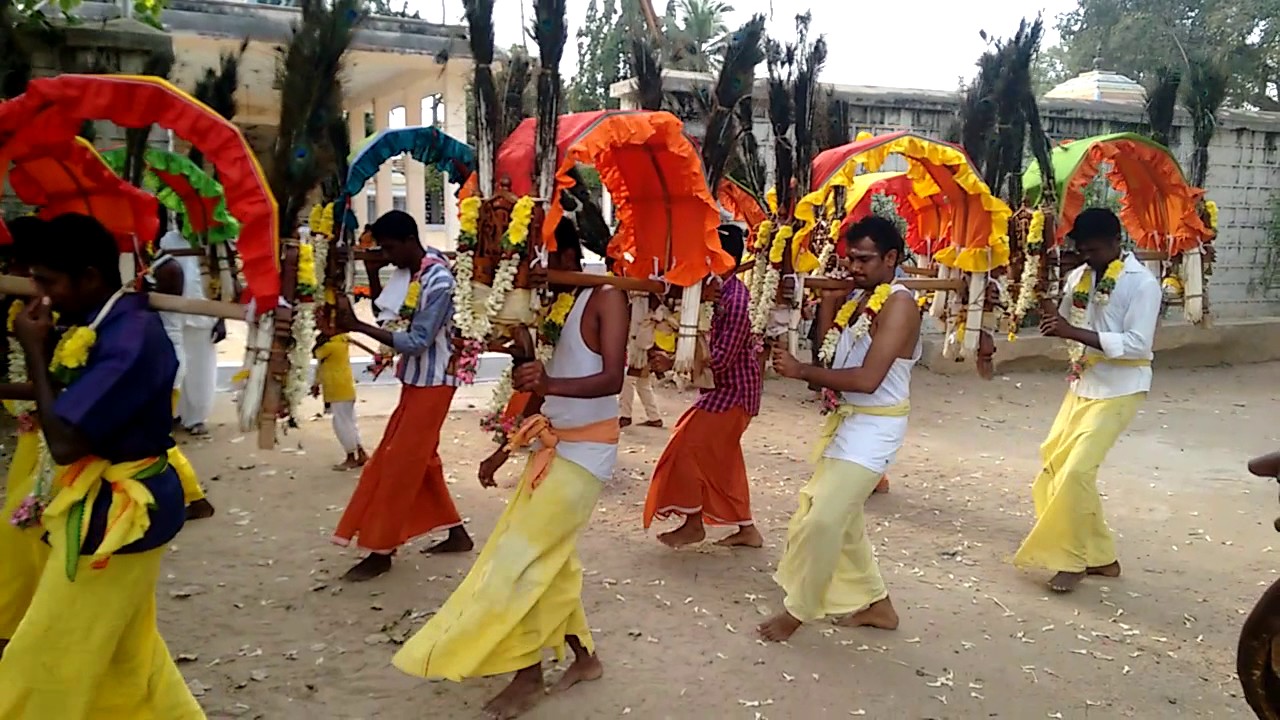
Long Bamboo stick, suspended with weightless bamboo pails , filled with flowers or other items as vowed by a devotee, at both the ends of the stick. This is made to rest on the shoulders of the devotee, swinging and swaying to the walk and dance of the devotees who travel a long distance by foot. Kavadi is dedicated to Lord Murugan on important festive occasions . Kavadi Chindu is the most popular lyrics used in Kavadi Attam. Annamalai Reddiar was the most popular composer in this form of art. Kavadi bearers wear Saffron, Yellow and Red costumes with a garland around their neck. This is believed as an endurance test to all the devotees to receive the blessings of Lord Murugan. Besides the Local audiences, it has tremendous support and appreciation in Sri Lanka, Mauritius, Singapore and Malaysia with a large diaspora of Tamils. Even in some Bharathanatyam Stages it is performed as a solo Kavadi Chindu number which entertains the audience thoroughly.
Poikkal Kudirai Aattam
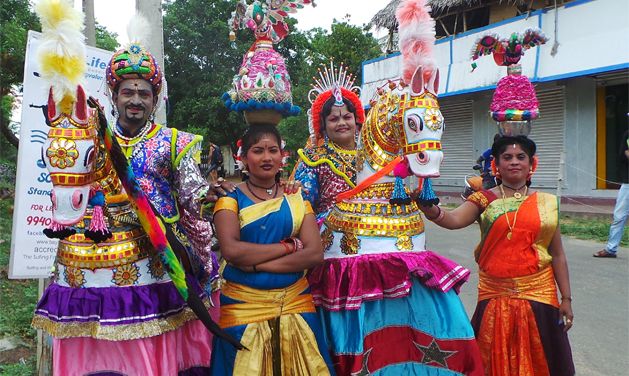
This is called as Dummy Horse Dance and also called as Puravai Attam the oldest Folk Dance format of the State of Tamil Nadu, is believed to have been introduced by the Maratha Kings. It is performed to please the Village Guardian God AYYANAR and also performed as a regular entertainment item during village festivals. This also has a releveance to the Sangam Literature Silapathikaram. This is a dance where performer adorns a DUMMY HORSE made out of convenient materials like jute, cardboard, paper mache and glass, have it tied to their hips. Wooden block tied to their foot to make the sound similar to that of the Hoods of a Horse. The movement is rhythmic that produces a scintillating effect, accompanied by music.
Kazhai Koothu
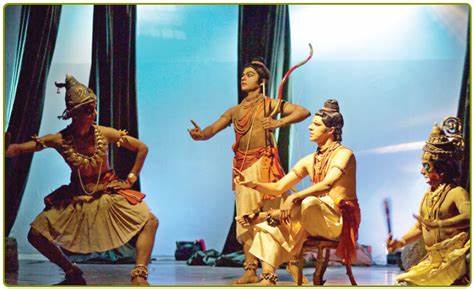
This folk art is a part of the rich history of art and entertainment of Tamil Nadu, similar to the present day Circus and something similar to a local Gymnastics. Balancing on a single rope and travelling the length of the rope between two poles firmly planted in the ground is the most common act. Walking on the ropes, Passing through the fire rings, youngsters doing acrobatic round of flexing their bodies and so on are some of the acts performed. They normally move like gypsies travelling from one place to another, perform and earn their livelihood. Thappattam : This is another Identified Folk Art of Tamil Nadu. The hand held Drum they use is called as Thappu hence this art is called as Thappaattam. The music from the drums is captivating, is that it attracts the audience in large numbers, normally played during the Temple Festivals and Social Gathering. This is basically a group play. Variances in this format of play is found in every zone and linguistic boundaries of the Country. This art mesmerizes the audience of all ages and denominations.
Bommalattam
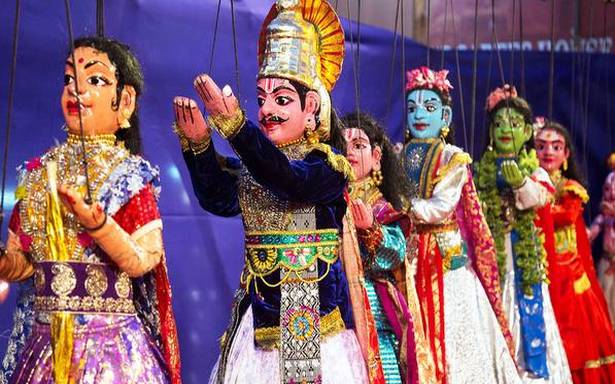
It is popularly called as the Puppet Show in English. Cultural messages and the scenes from the great Epics of Ramanayam, Mahabharatham are performed through the puppet show. It is enacted and spread through the performers from behind the screen, with the help of Dolls in the foreground. Iron rods are suspended from above and the dolls [only visible through a window opening from a height of 10 ft. height] are connected by black strings manipulated by the performers from behind [not visible to the audience] to achieve different movements of the dolls to fulfill a sequence and the play is enacted from the beginning to the end.
Bagavatha Nandanam
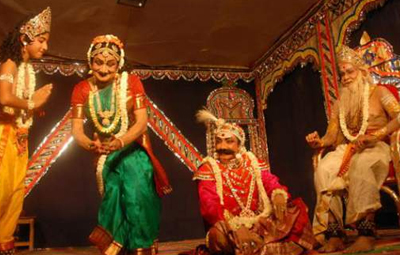
This is colourfully celebrated during the festivals of Ramanavami and Gokulashtami in Lord Krishna Temples. A huge lamp is lit in the temple and the Dance is performed going around it is called Bagavatha Nadanam by singing songs in praise of Lord Krishna.
Theru Koothu
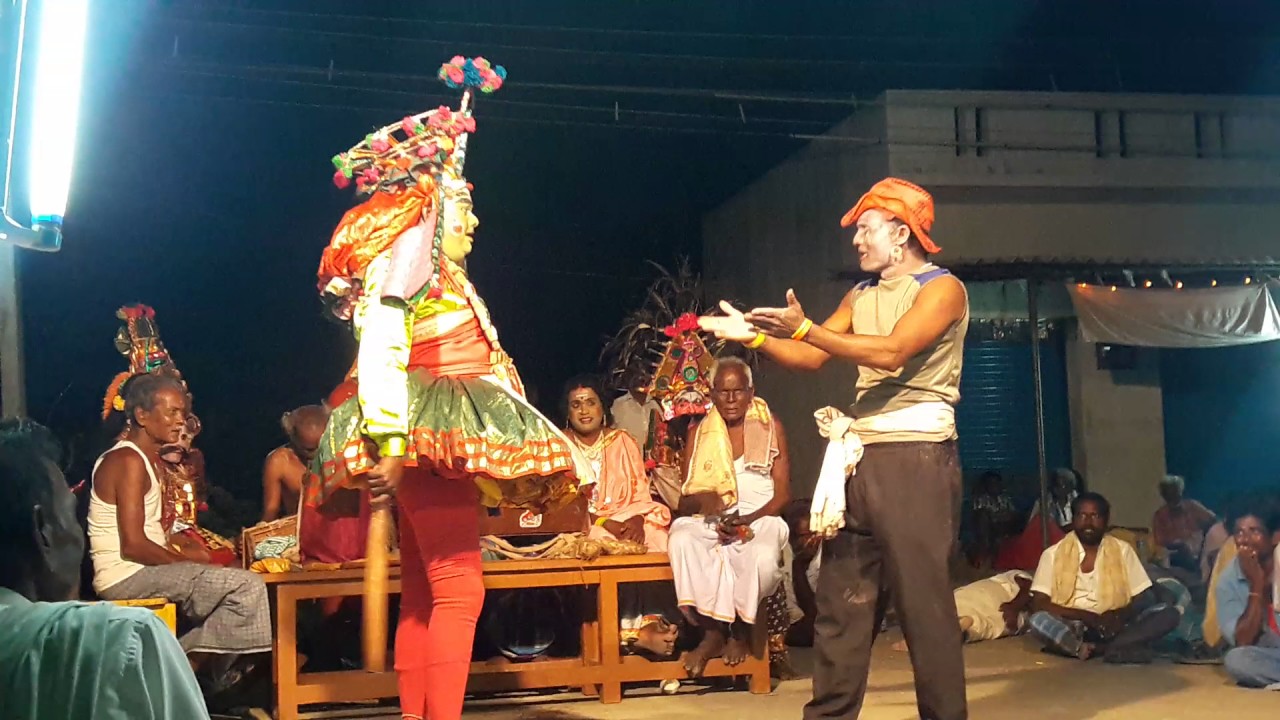
It was the best media of the yester years to propagate messages of religious or social importance to the people in villages. It is a village Open Air Theatre performance that begins in the evening and sometimes continues throughout the night and people keep awake and enjoy. The Music Troupe on the sidelines of Stage narrates the entire sequence , sings songs and plays music to suit the scene. It is completely a Male performers Domain and even the female charecters are played by men with colourful and heavy costume. The artistes require all round and good performing ability. Theru Koothu is popular in the northern districts of Tamil Nadu. Nattu Koothu including Valli Koothu, Kuravai Koothu, Samaya Koothu, Pei Koothu [demon] including Thunangai Koothu and Porkala Koothu [War time] are some categories of its kind.
Devarattam
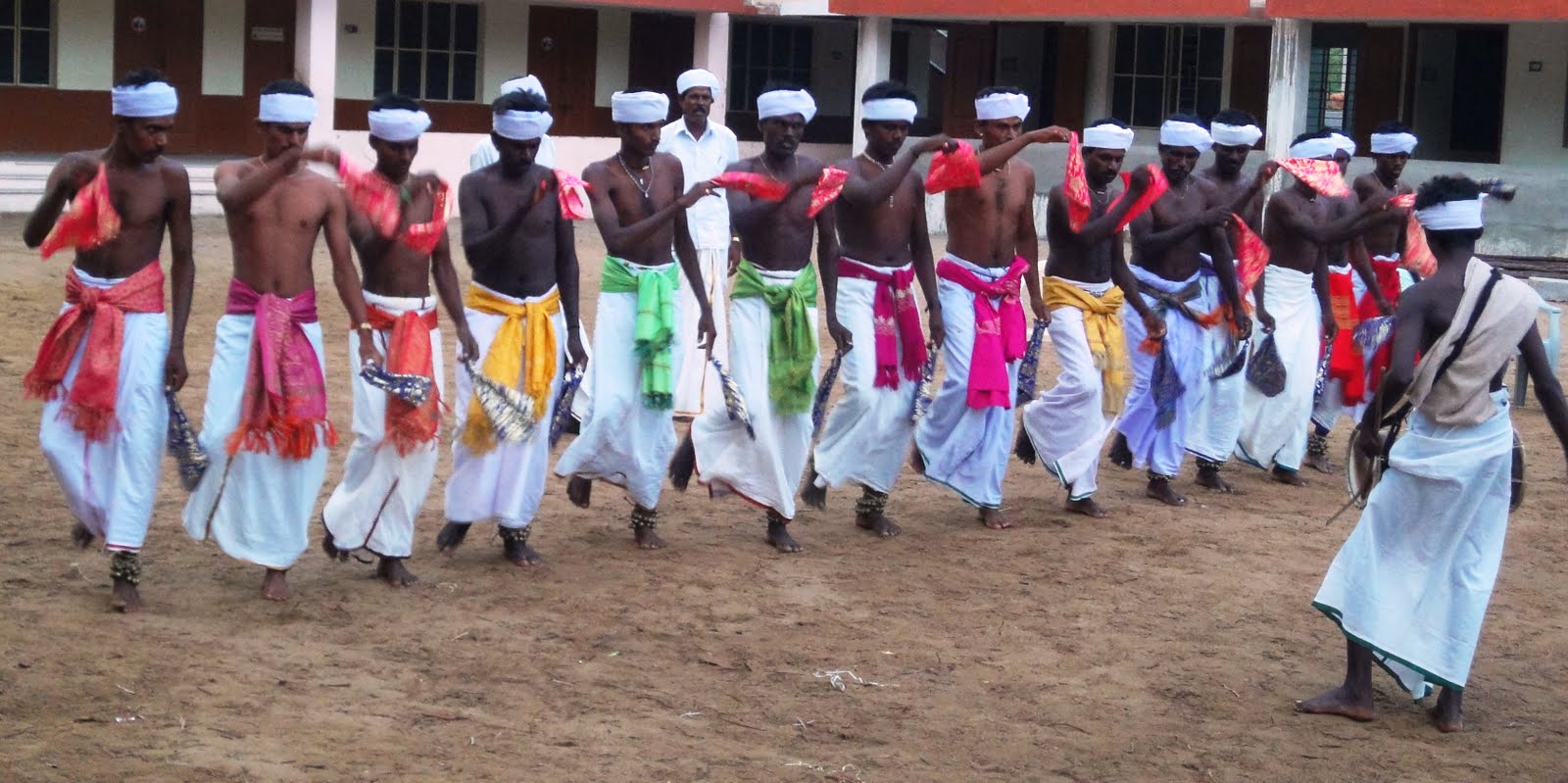
It is considered as a Ritual as well a Social Folk Dance. This form of the folk dance is still practiced and preserved by the Kambala Nayakar Family, the descendants of the popular King and Freedom Fighter Veerapandiya Kattabomman. The Kambala dynasty is located at Kodangipatti of Madurai District. Because they consider themselves as ‘Devars’[ ‘God’] this art is called Devarattam. This dance was performed by them in the temples belonging to the community. The dancers hold a piece of cloth in both their hands and dance to the tune. This folk dance is considered as a combination of “muntherkuruvai” and “pintherkuruvai” of the ancient Tamil Kings. Devarattam was performed also to celebrate the victory of the king, in front of his Chariot, on his return from a victorious war front. . The King and his Marshals will dance on the deck of the chariot, the soldiers and female dancers would form in lines and dance from behind the chariot. Today, this does not have songs but performed to the beat of Urumi Melam, Thappu Melam and sometimes long flute. The Lead dancer makes the first step and others follow it.
Oyilattam or Oyil Kummi
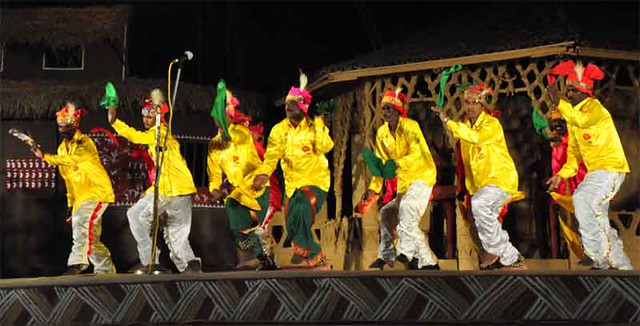
Oyil meas Grace or Elegance and a Dance in such a style is called as Oyilattam. This form of folk dance has its roots in Southern TamilNadu and performed in the districts of Madurai, Tirnelveli and Tiruchirapalli. It was traditionally a dance where a few men would stand in a row and perform rhythmic steps to the musical accompaniment, with the number of dancers increasing. It was a Male domain till recently, but women have also started performing this dance. The performers wear anklets with bells and a color cloth tied to their fingers. Women wear Saris with a cloth around their waist and decorate themselves with jewelry accessories. The Musical accompaniment is Thavil , that is played by the artiste themselves. They enact sequences from Epics like Ramanayam , Mahabaratham and many performances relates to Lord Murugan.
Snake Dance
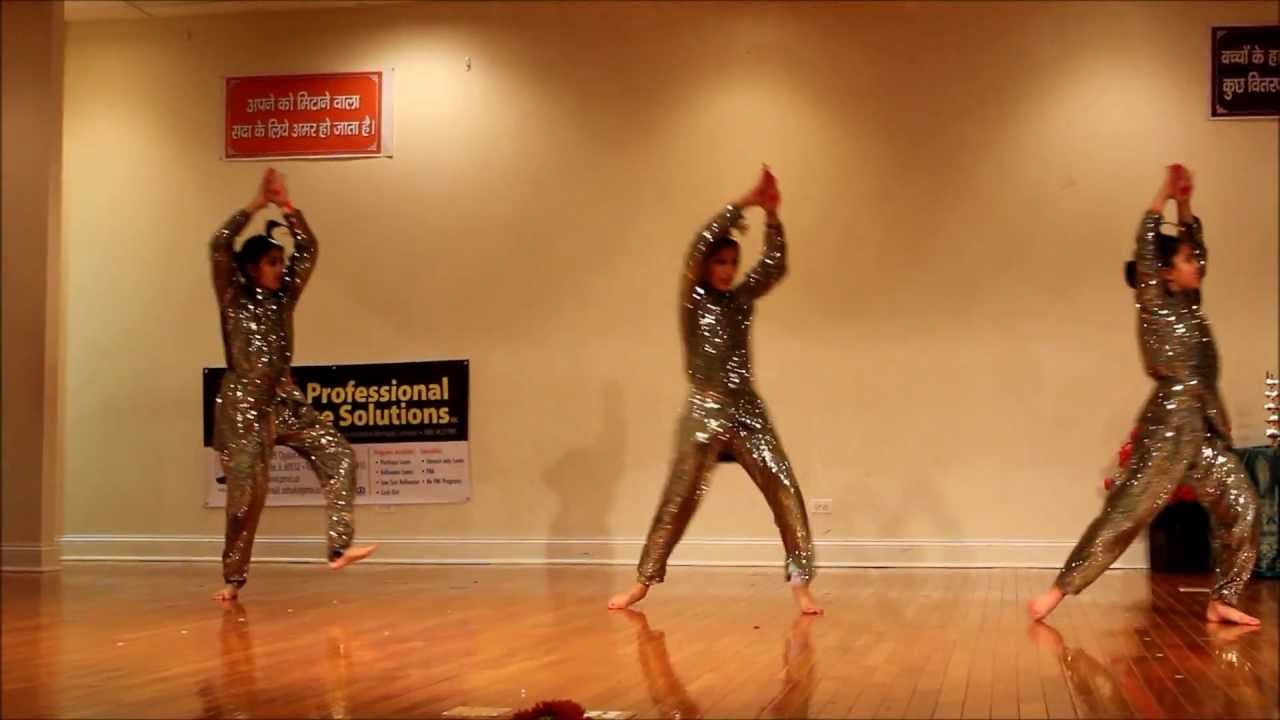
Locally called as Paambu Attam / Dance. This is yet another art of the Southern Districts of Tamilnadu , generally performed by village women folk. The community believed, snake with reverence to Lord Murugan, as a protective divinity. They adorn skin tight snake skin costume and make movements like a snake, writhing with twists and turns. Flexibility of body and stimulating capacity is the most important features of the dancers.
KARAGATTAM
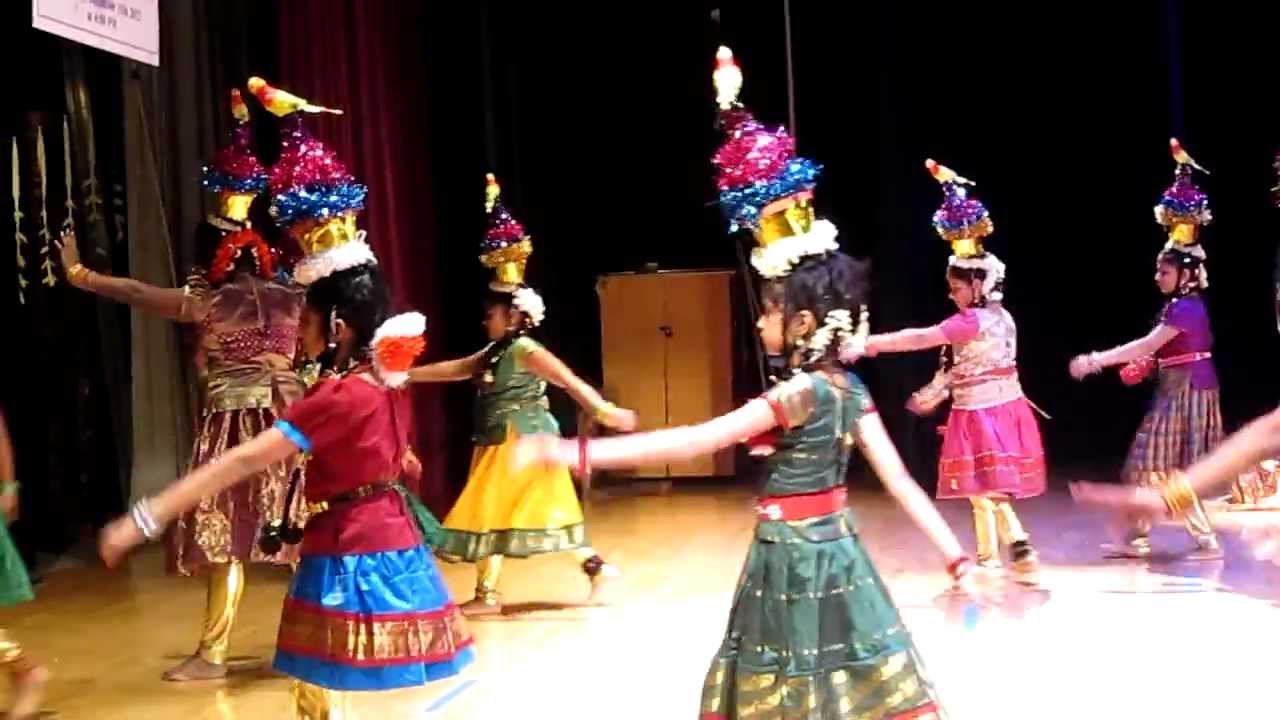
It is a dance dedicated to Goddess Mariamman who is believed to bestow the earth with rains and making it a cool place to live in. Karagam was earlier performed during MULAIPARI festival in Muthulapuram, by carrying the sprouted grains on head and dance to the tune, balancing the sprouts. This type of dance is generally classified in two categories. Aatta Karakam [just for fun and play], one of the two type is performed with a decorated pot on head doing the balancing act, which makes every one happy and joyful. The other category is called Sakthi Karakam which is performed only in temples during the festival to fulfill the religious aspect of the art. During the early days it was performed with Naiyandi Melam at the background. This dance can be performed by both men and women, single , by pairs or as groups. Act of dancing on a rolling block of wood, going up and down a ladder, threading a needle are some acrobatic movements performed by the dancers. Thanjavur, Pudukottai, Ramanathapuram, Madurai, Tirunelveli, Pattukottai, and Salem Districts of Tamil Nadu have produced excellent exponent groups of this art. This art finds significant attraction amongst neighbouring countries like Singapore, Malaysia and Sri Lanka known for territories occupied by Tamil Minorities population.
KUMMI
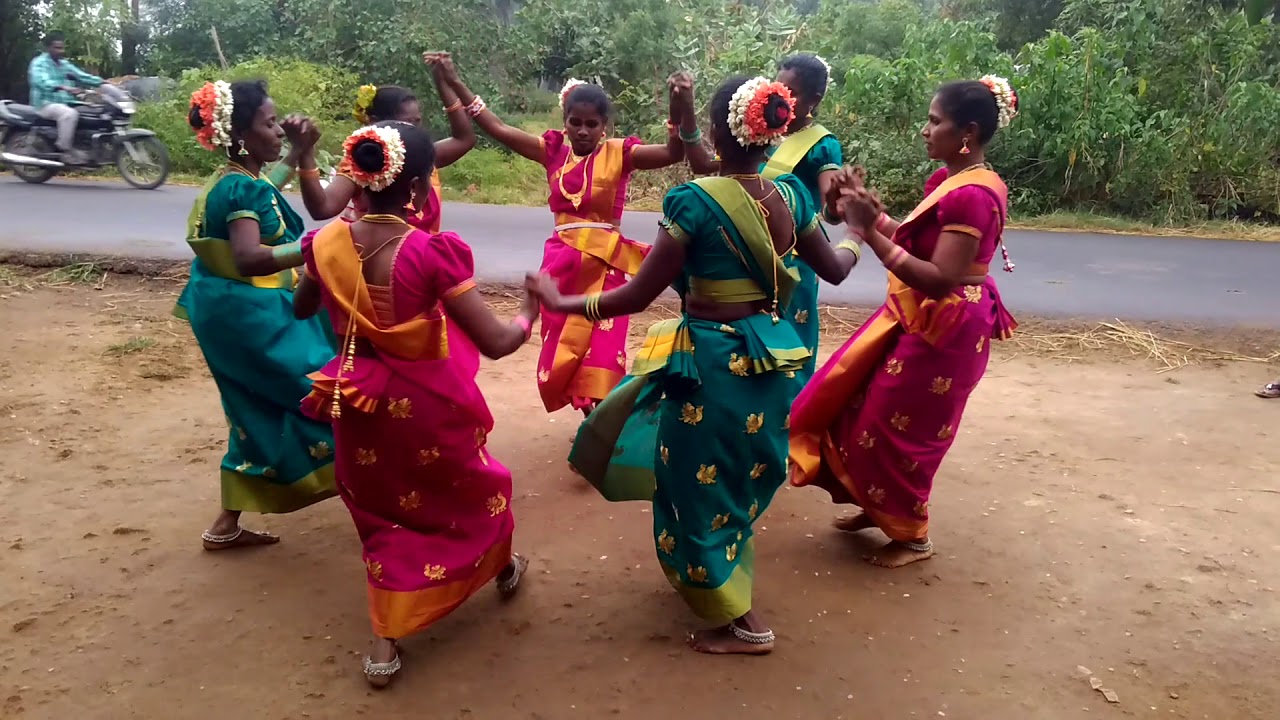
This is a dance performed by Girls and Ladies positioned in a circle and dance to the clapping of their hands rhythmically to a tune. This art is practiced in Tamil Nadu and Kerala. Kummi needs no season and reason. When girls join together it becomes festival for them and Kummi is on. Women folk have designed special songs for different occasion and they sing and dance. Poonthatti Kummi, Deepa Kummi, Kulavai Kummi, Kadir Kummi, Mulaipari Kummi are some styles of this Art. They move in circle and the hand gestures the reaping motion and the harvesting process. One of the women leads the singing, and each one of them start a new line of the song and it goes on till they are tired. In some regions, initiating variations, Men play this dance with clapping of a stick on the outer circle, and the women in the inner circle clap their hands rhythmically to synchronize it with men. Temple Festivals, Harvest Festival and any family functions will have Kummi in their entertainment agenda.
Mayil Aattam
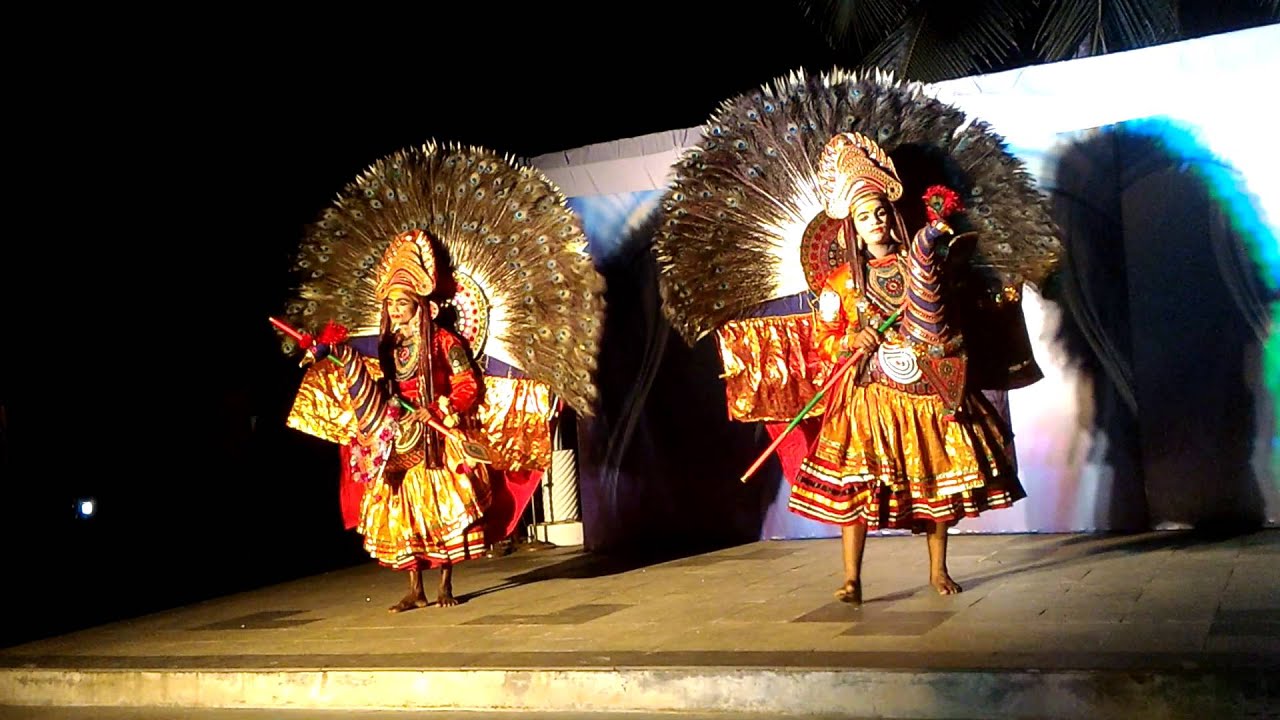
It means Peacock Dance. It is a religious folk art performed in Temples dedicated Lord Murugan who has peacock as Vagnam, to please him and obtain his blessings. It is an artistic dance performed with a costume of Peacock with Real Feathers at the back and its beak in place. The walk and dance of these dancers will be similar to that of a peacock. The grace in which they perform thrills the audience. This requires an extensive practice to perform with grace. Because of this reason the interest towards this art is fading slowly. Efforts are being taken to encourage this Folk Dance. Kaalai Attam [Bull], Karadi Attam [Bear] Asli Attam [demons] are other forms of this style. Mayilattam is performed during the Arattu festival style in Thiruvambadi Sree Krishna Temple, Varkala.
Kolattam
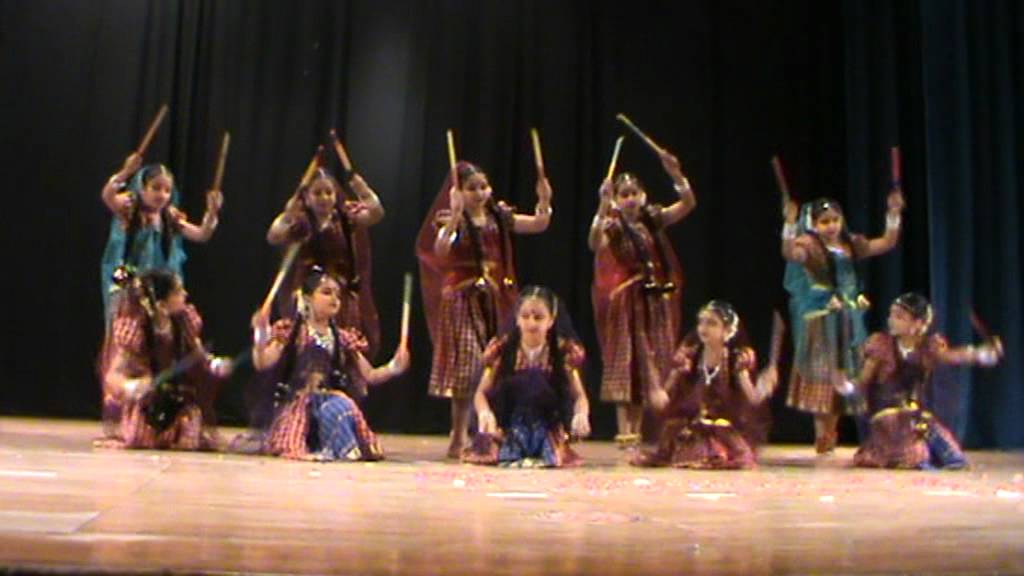
The southern India is famous for patronizing this art and cultural activities which has transformed the social scenario of these states. Koladi, Kolkali and Kambadi Kali are the other names of this art in some regions. Kolattam is mentioned in Kanchipuram as ‘Cheivaikiyar’ which testifies its rich heritage and antiquity. Kol = Stick and Attam= Play. It is amost similar to Kummi. The only difference is that the women folk use Small colourfully painted and decorated wooden sticks instead of clapping their hands. The graceful movements, benign expressions and alluring rhythms all blend magnificently in the performances of the dancers performing this art.
Urumi Attam
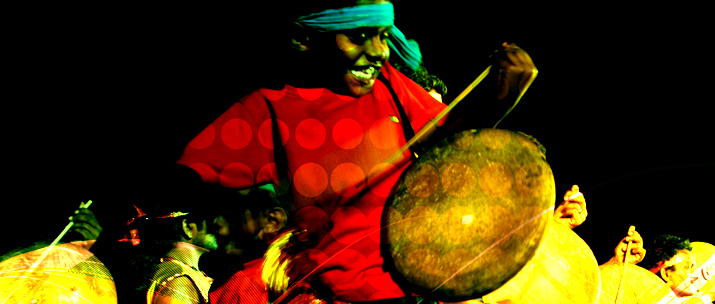
It is a form of folk dance mostly performed in the temples especially in Amman temples during puja hours or on different festival occasions of the temple . The whirrrring of ‘URUMI’ melam sound that provides a lively melody and the beat is similar to that of Thappu Melam. It is mostly performed by men either single or in group of few performers.
Ottan Koothu
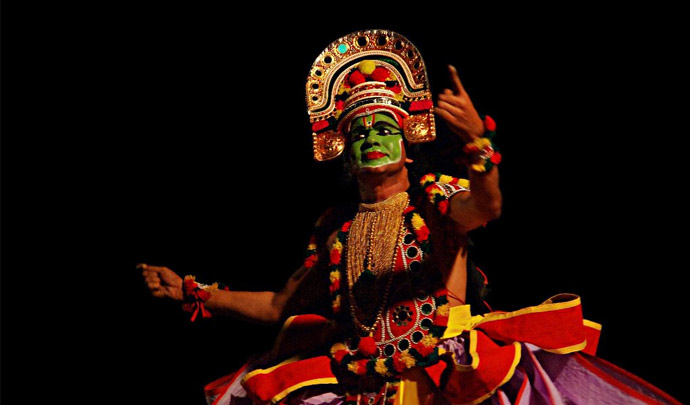
It is a folk art practiced by a small group of tribals, performed by both Men and Women. Sequences from ancient stories and other epics are taken as subject to educate the people.
Kamandi or Kaman Pandigai
This is celebrated to commemorate the puranic event when Manmada [God of Love] was burnt to ashes by Lord Siva in anger. The Villagers form themselves as two groups called Erintha Katchi and Eriyatha Katchi ( burnt / unburnt ). A debate ensues and reaches the culminating point. Kaaman/Manmadan and Rathi are the main charecters of this art.
Puli Attam
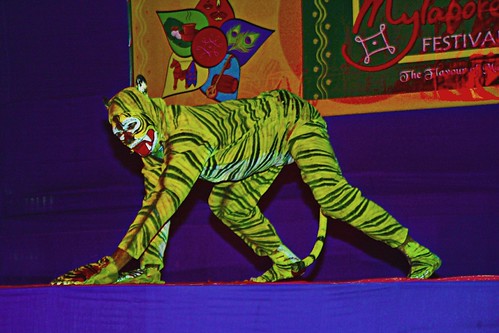
Young Men folk and Boys play this dance to thrill the audience in different parts of Tamil Nadu. In kerala this dance is performed as Puli Kali during onam celebrations. Their body is coloured with vibrant Black and Yellow strips resembling a Tiger Skin, with Fangs, head mask, paws and claws in place. The performers display the gracious walk and ferocious movements known to the wild, matching the frenzy beat of the drums. Modern day performers wear Skin tight Tiger Stripe dress for their convenience. This dance attracts large crowd during the temple festivals.
Kali Attam
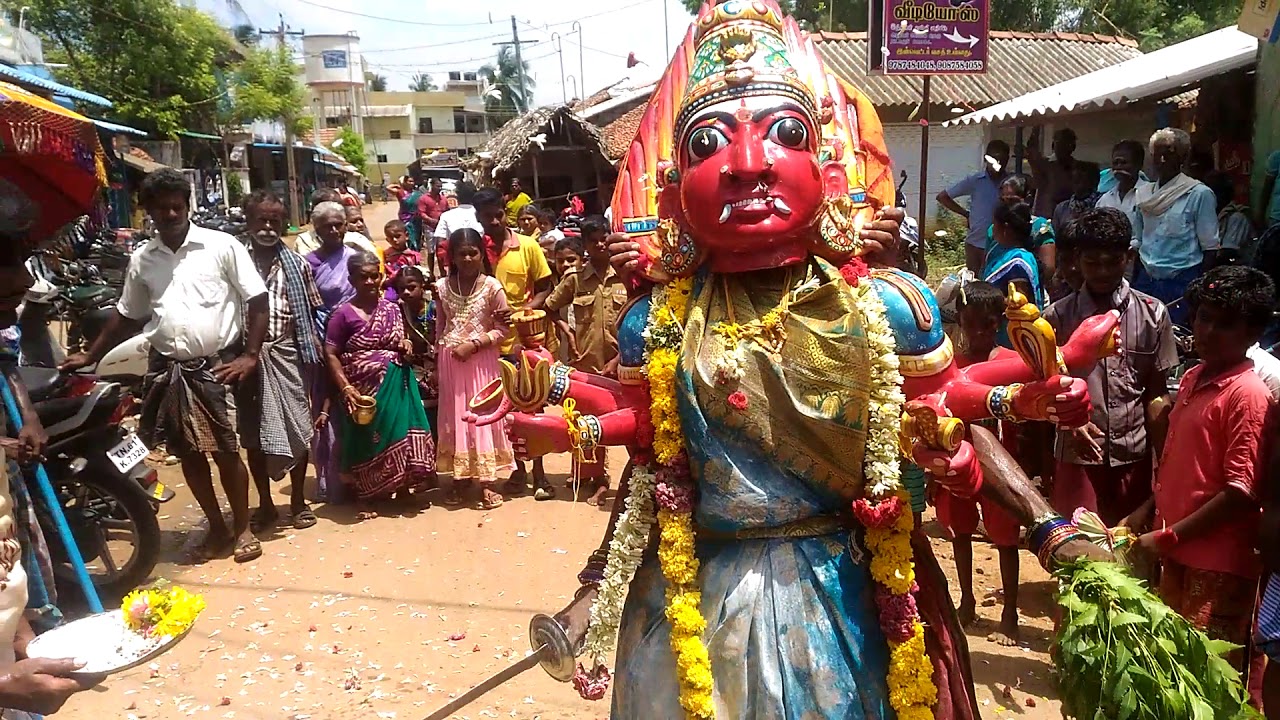
Kali means joy or fun and games. This is also known as Koladi, Kokkali, Kambadi Kali and Kolattam. Sticks of one foot length are held in each hand and beaten to make a sharp, rasping sound as the dance proceeds with unique steps, twisting and turning. It is performed by both men and women, during festivals, auspicious days and weddings. The players should be Quick, and alert or else chances of getting hurt by the ‘kol’ or Stick is common. The ‘kols’ made of wood are brightly painted and decorated with brass rings and bells. The dancers used to wear ankle-bells. However, there isn’t any special dress or make up is ear marked for this dance.
Sevai Attam
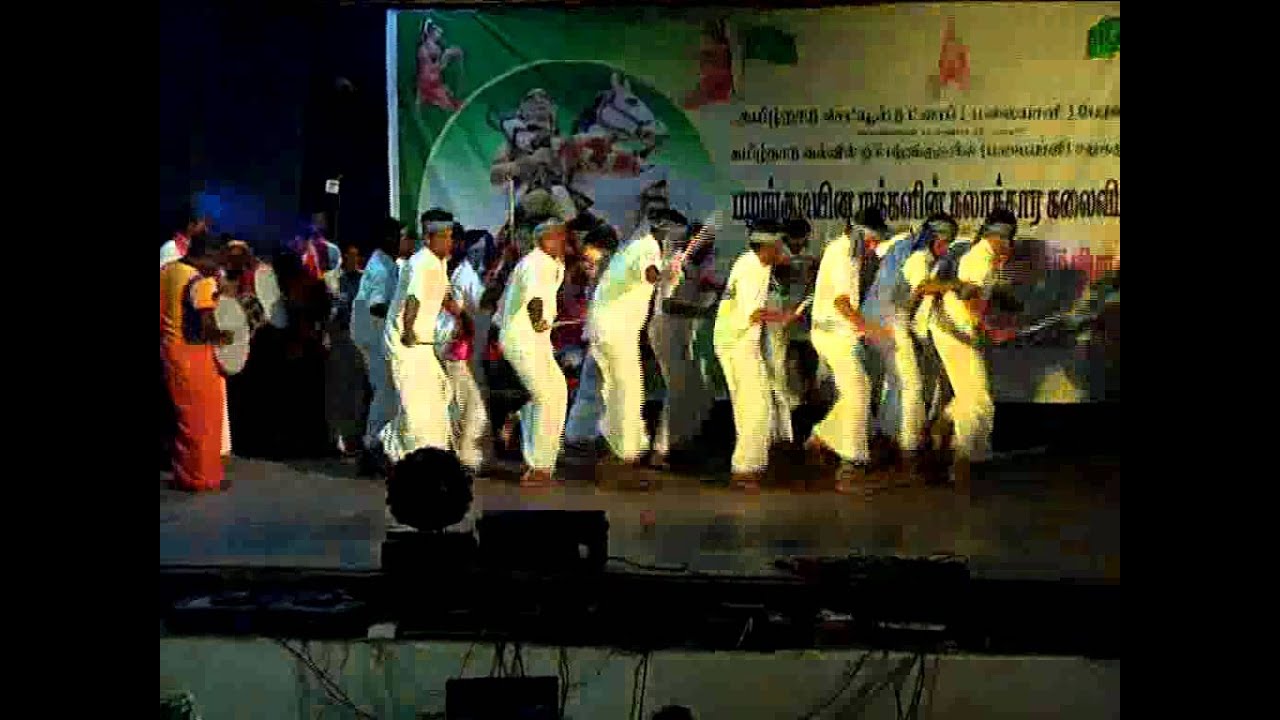
This is performed by Village folk community called Nataka Community and this form of art dedicated to ‘Thirumal’ [Lord Maha Vishnu]. In this dance, the performers forming a group, with one of them performing the role of a Clown or a Bufoon, dance to the music of drumming instrument like ‘Urumi’. The classical songs and the deliberate steps with graceful moves are the unique features of Sevai Attam. In Sangam Literature this was called as ‘Pinther Kuruvai” normally played from the rear of the Chariot Procession, either of a Victorious King or of a Temple Deity.
Villu Pattu
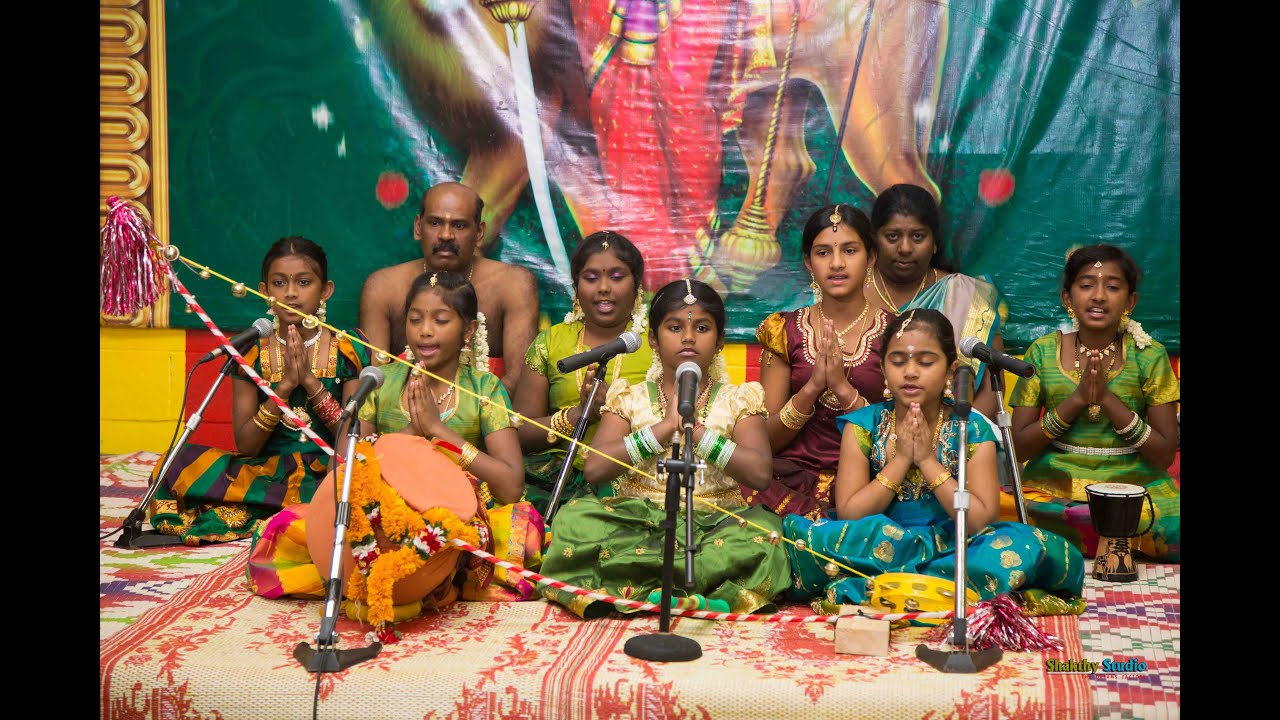
Villu means Bow. This is a folk art where performers Narrate stories of Historical, Reglious sequences through song, with Villu [Bow] as the main instrument. It is also known as Villadicham Pattu. Practiced in the areas of Kanya Kumari, Thovalai and also in Kerala. It is generally popular among the Nadar and Ezhava [of erstwhile] Travancore communities. Udukkai, Kudam and Thala Kattai are other instruments used to add flavor to the performance. In Lavani Pattu of Villu pattu, the performers are usually divided into two groups to prove two sides of a subject. The main story teller narrates the story striking the bow. And accompanying troupe repeat or utter appropriate responses orally. They occasionally assist the local government to propagate social messages and propaganda.
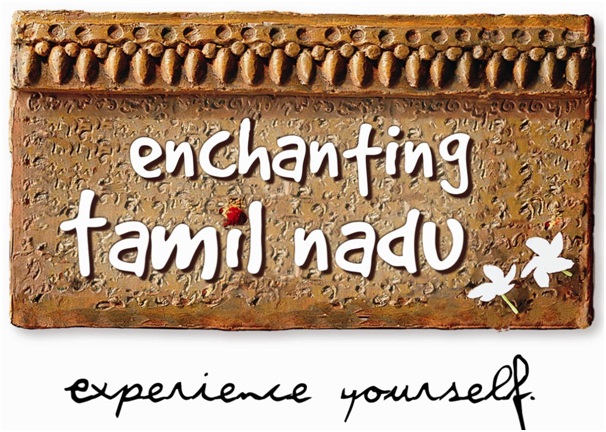
Best Selling Tour Packages
Charming Hills Coastal Odyssey Southern Triangle Cultural Carnival Pilgrim Blessing Heritage Magic Wild Hills Misty Hills
Honeymoon Tour Packages
Extreme Privacy Romance @ Hills Amazing Love Love @ Coast Romantic Honeymoon Romantic Bug
Hill Station Tour Packages
Mist Valley Enchanting Hills Morning Drizzle Hills & Wildlife Wandering Hills Weekend Hills
Beach Tour Packages
Beach Fantasy Pristine Beaches Beach Wanderlust Sun N Sand Romance @ Coast Beach Nomad
Wildlife Tour Packages
Go Wild Love Tiger Amazing Wild Extreme Wilderness Wild @ Hills Wandering Wild
Temple Tour Packages
Temple Darshan Majestic Temples Magnificient Temples Historical Temples Temple Pilgrimage Vibrant Temples
Historical Tour Packages
Historical Splendor Historical Grandeur Historical Spectacle Historical Marvel Historical Glory Historical Beauty